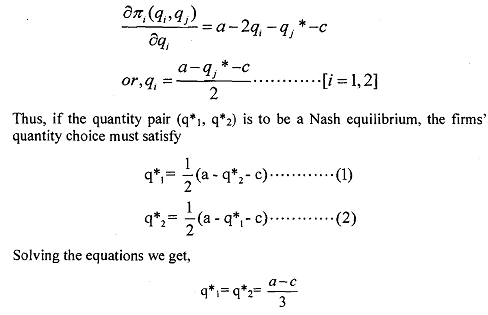Pure strategies:
In all the game we have studied so far, each player had only a finite number of pure strategies at her disposal. But consider the games in which the player is choosing price, quantity or expenditure or to be specific a variable, which is continuous in nature. In this section, we will discuss how to find Nash equilibrium in such games.
The method we will employ to find the Nash equilibrium in such games is known as the "best response analysis". We know that in equilibrium, each player's strategy must represent her best response to that of her rival. In case pure strategies, which are continuous in nature, we can plot the best responses of a player against the possible strategies of the other player. This will be a continuous curve as the strategy space of the other player is also continuous (we ignore the case where the strategy space of the other player could be discrete). This is known as the "best response curve" or the "reaction function". Nash equilibrium is the combination of strategies where the two best response curves intersect in the strategy space.
We will illustrate the above method by solving the Coumot model of duopoly.
Let ql and q~ be the quantities of a homogeneous product produced by firms 1 and 2, respectively. We assume a simple demand curve, P (Q)= a - q, which gives the market clearing price when aggregate quantity in the market is (ql + q? 1. To be more precise,

Let us assume that the cost of producing quantity q, for the i" firm is given by C, (q,) = c. q,, which implies that there is no fixed cost of production and the marginal cost of production is c, which is constant at c. We further assume a > c, Following Cournot, firms simultaneously choose the quantity of output they will produce and their payoff function is their profit.
In order to find the Nash equilibrium of the game we first translate the problem in to a normal form game. Recall from previous unit that a normal form game must specify,
i) players of the game
ii) strategies available to each player
iii) payoffs received by each player after strategic interaction.
There are 2 players in this game firm 1 and firm 2.
The strategies available to them is a continuous variable, it is the quantity it might be produced. We assume that quantities are continuously divisible (we trivially exclude negative output). Thus, the strategy space of each player is Si - [0, a), which is non-negative real numbers, in which case a typical strategy s, is a quantity choice, q, 2 0.
As we have defined earlier, the payoff of the firms is the profit, which given by

The strategy pair (q*,, q*$ is a Nash equilibrium if for every player q*, (i=1,2) must solve the optimisation problem,

The first order condition for firm i's optimisation problem is both necessary and sufficient. It yields,

Equation 1 gives the best response curve of firm 1 and equation 2 gives the best response curve of firm 2. They intersect at
 (Try to solve the game graphically)
(Try to solve the game graphically)